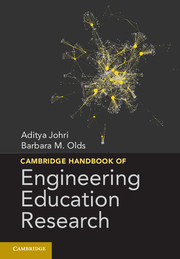Book contents
- Frontmatter
- Dedication
- Contents
- Editors
- Contributors
- Foreword
- Acknowledgments
- Introduction
- Chapter 1 Chronological and Ontological Development of Engineering Education as a Field of Scientific Inquiry
- Part 1 Engineering Thinking and Knowing
- Part 2 Engineering Learning Mechanisms and Approaches
- Chapter 8 Problem-Based and Project-Based Learning in Engineering Education
- Chapter 9 Case Studies in Engineering
- Chapter 10 Curriculum Design in the Middle Years
- Chapter 11 Engineering Design Education
- Chapter 12 Adaptive Expertise and Knowledge Fluency in Design and Innovation
- Chapter 13 Learning Disciplinary Ideas and Practices Through Engineering Design
- Part 3 Pathways into Diversity and Inclusiveness
- Part 4 Engineering Education and Institutional Practices
- Part 5 Research Methods and Assessment
- Part 6 Cross-Cutting Issues and Perspectives
- Index
- References
Chapter 8 - Problem-Based and Project-Based Learning in Engineering Education
Merging Models
Published online by Cambridge University Press: 05 February 2015
- Frontmatter
- Dedication
- Contents
- Editors
- Contributors
- Foreword
- Acknowledgments
- Introduction
- Chapter 1 Chronological and Ontological Development of Engineering Education as a Field of Scientific Inquiry
- Part 1 Engineering Thinking and Knowing
- Part 2 Engineering Learning Mechanisms and Approaches
- Chapter 8 Problem-Based and Project-Based Learning in Engineering Education
- Chapter 9 Case Studies in Engineering
- Chapter 10 Curriculum Design in the Middle Years
- Chapter 11 Engineering Design Education
- Chapter 12 Adaptive Expertise and Knowledge Fluency in Design and Innovation
- Chapter 13 Learning Disciplinary Ideas and Practices Through Engineering Design
- Part 3 Pathways into Diversity and Inclusiveness
- Part 4 Engineering Education and Institutional Practices
- Part 5 Research Methods and Assessment
- Part 6 Cross-Cutting Issues and Perspectives
- Index
- References
Summary
Introduction
In the practice of engineering education, there is a wide variety of implementations of problem-based or project-based learning (PBL). In this chapter we aim to explain the relationships between different types of problem-based and project-based learning to help teachers and educational managers make innovative choices and provide benchmarks for educational researchers. We present a combined understanding of problem- and project-based learning, the theoretical and historical background, and the different models of PBL that can capture the existing practices, ranging from small- to large-scale practice, from classroom teaching to institutional models, and from single-subject to interdisciplinary and complex knowledge construction.
It is well known that one-way dissemination of knowledge by means of lectures is not very effective in achieving learning (van der Vleuten, 1997). In higher education concepts such as “self-directed-learning,” “case-based learning,” “inquiry based learning,” “experiential learning,” “service learning,” “project-based service learning,” “active learning,” CDIO (Conceive, Design, Implement, and Operate), “project-based learning,” and “problem-based learning” were introduced in the decades after the Second World War. All these new learning concepts come under the umbrella of learner-centered or student-centered learning models. Problem-based and project-based learning, both known as PBL, originate from the reform universities, and the new educational models, established between 1965 and 1975. In problem-based learning, problems form the starting point for students’ learning emphasizing a self-directed learning process in teams. The educational model problem-based learning was introduced at curriculum scale at the medical faculty of McMaster University, Canada, followed by Maastricht University in the Netherlands and many others. Project-based learning shares the aspect of students working on problems in teams, but with the added component that they have to submit a project report completed collaboratively by the project team. The problem- and project-based/project organized model adopted at Aalborg University and Roskilde University, Denmark, was inspired by the critical pedagogy in Europe after the student revolts of the 1960s. At Aalborg University both models of PBL were eventually combined in problem-based project organized learning, which was practiced at all faculties – the Faculty of Engineering and Science being the largest. This combined approach is the central point of reference for this chapter, as the pedagogical development in engineering education indicates that both educational practices are successful in their own way and the abbreviation PBL is here defined as including both practices.
- Type
- Chapter
- Information
- Cambridge Handbook of Engineering Education Research , pp. 141 - 160Publisher: Cambridge University PressPrint publication year: 2014
References
- 153
- Cited by

